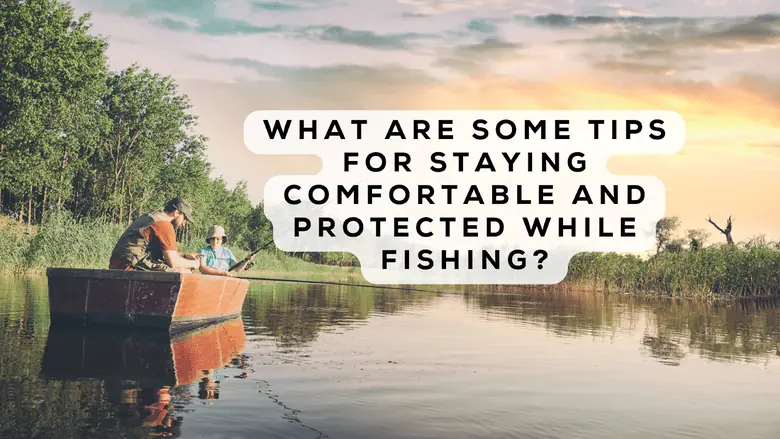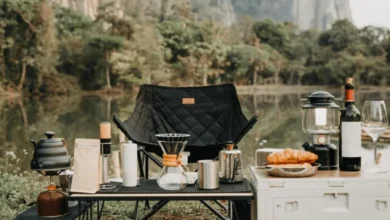What Are Some Tips for Staying Comfortable and Protected While Fishing?

The fishing dream: kicking back lakeside as the sun peeks over the trees, landing the big one after an epic battle. Sounds fun, right? However, reality sets in. Wet waders can chill you to the bone. Mosquitos eat you alive. The beating sun burns your neck. Your back screams from standing in one spot for hours. It’s not as dreamy anymore.
Fishing has its discomforts for sure. Studies show that most anglers face discomforts such as pain, sunburn, sore feet, wet clothes chafing, and musculoskeletal problems.
But it doesn’t have to be this way! With the right gear and some smart planning, you can make even the longest fishing trip a comfortable, pleasant experience. In this guide, we’ll share insider tips to keep you warm, dry, protected, and ache-free from start to finish. Prepare to bid farewell to wet socks and sunburns this season. Let’s begin making fishing comfortable again!
Choose Clothes That Keep You Dry
Wet clothes can make you cold fast. When selecting your fishing clothing, prioritize pieces crafted from waterproof or fast-drying materials like polyester, nylon, and neoprene. It’s not just about staying dry; it’s a smart move to ensure you remain comfortable and warm during your fishing escapades.
-
Look for waterproof fabrics
When shopping for fishing gear, look for items made with waterproof fabrics like Gore-Tex or HypTex. These will keep you dry even in rainy or splashy conditions.
-
Focus on Moisture-Wicking Base Layers
It’s important to wear moisture-wicking, quick-dry fabrics directly against your skin. Synthetic base layer shirts and leggings will keep you driest. Avoid cotton which stays wet.
-
Get Fishing Pants with Reinforced Knees
Look for rugged fishing pants with waterproof fabric and reinforced knees so you can kneel on the ground comfortably. Make sure they have zippered pockets that won’t leak if you fall in.
Add a waterproof hat to keep rain off your head and face too.
Layer Up
Bring lots of lightweight layers you can add or remove as needed. Base layers that wick away sweat will keep you driest. Top with a fleece or sweater mid-layer for warmth. Have an insulated, waterproof outer jacket as well. Don’t forget rain pants, too. Being able to adjust layers prevents getting too hot or cold.
-
Have Breathable Mid-Layers
For middle layers, fleece jackets and sweaters work well to trap body heat while still breathing. Look for moisture-wicking performance fabrics.
-
Invest in a Quality Rain Jacket
A good waterproof, breathable rain jacket shell is worth the investment. Look for coated nylon or Gore-Tex materials with sealed seams and storm flaps over the zippers. It should have a hood as well.
-
Carry Extra Layers in a Waterproof Pack
Use a waterproof backpack or bag to store extra layers and supplies. That way, everything stays dry until you need it. Easy access to spare layers is essential.
Ensure Sun Protection
Lots of time in the sun without protection can be dangerous. Wear a hat that shades your face, ears, and neck from too much sun. Look for lightweight shirts with a hood and UV protection built in. Use sunscreen of SPF 30 or higher on any exposed skin and reapply often. Sunglasses also help protect your eyes.
-
Get a Wide Brim Fishing Hat
A wide-brim hat keeps more sun off your face and neck. Look for fishing hats with vents, chin straps, and a drawcord to adjust the fit in windy conditions.
-
Use Fishing Shirts with Built-in Hoods
Fishing shirts made from lightweight polyester or nylon work well. Look for ones with built-in hoods for extra coverage and sun protection.
-
Have UV-Blocking Buffs or Face Masks
For full protection, use sun-protective Buff neck gaiters and face masks. They block UV rays and breathe well.
-
Pack Polarized Fishing Sunglasses
The glare of the water can be blinding. Good polarized fishing sunglasses cut that glare and protect the eyes. Make sure they have UV protection too.
Invest in Quality Fishing Shoes
Special fishing shoes or boots help your feet stay dry and get good traction on slippery surfaces. Fishing waders that cover your legs are even better for cold water. Make sure any boots have thick soles for standing on rocks. If they have spikes or cleats, that’s even better for grip.
-
Look for Waterproof Boots with Lug Soles
For shore fishing, waterproof boots with deep, lugged rubber soles give the best traction on slippery terrain. Make sure they cover your ankles as well.
-
Check Out Fishing Wading Boots
High-wading boots made for fishing have felt or rubber soles to grip underwater rocks. Look for boots rated as insulating for warmth. Add neoprene socks for extra insulation.
-
Don’t Forget Non-Slip Deck Shoes
For fishing from a boat, you’ll need non-slip, non-marking deck shoes with mesh panels. These drain water easily while providing traction on wet surfaces.
Bring Extra Socks and Gloves
Even with good shoes or boots, feet can get wet and cold. Pack extra socks to change into if needed. Neoprene gloves will keep your hands warm in case of a temperature drop. You want maximum freedom of movement while also being able to warm up cold fingers.
-
Keep Extras in a Dry Bag
Store extra dry socks, gloves, and other cold-weather gear in a waterproof dry bag. That way they’ll stay totally dry and ready to use. Having backups can be a lifesaver.
-
Try Heated Socks and Gloves
For cold-weather fishing, battery-powered heated socks and gloves are great. They’ll keep your extremities nice and toasty for hours. Just recharge the batteries between trips.
-
Opt for Fingerless Fishing Gloves
For talent in cooler temps, look for fingerless fishing gloves. They protect your palms and the backs of your hands without limiting movement.
Use Insect Repellent
Don’t let bites from mosquitos, ticks, and other pests ruin your day. Use sprays, lotions, patches, or clothing treated with insect repellent. Reapply frequently. Check your body for ticks after fishing, especially if in wooded areas. Removing them quickly lowers the risk of illness.
-
Apply Repellent Under and Over Clothes
For best protection, apply insect repellent directly on the skin, and also spray your outer layers. This creates a barrier to keep bugs at bay.
-
Consider Natural Plant-Based Formulas
For those looking to avoid harsh chemicals, plant-based repellents using lemon eucalyptus or soybean oils also work well. They protect without strong odors.
-
Wear Insect-Repellent Fishing Gear
Look for fishing shirts, pants, and hats pre-treated with effective insect repellents like permethrin. This treatment sticks through multiple washings.
Pack Useful Gear
A foldable fishing chair lets you get comfy instead of standing the whole time. A cooler with snacks and drinks stays energized. Have a sunshade or umbrella to get out of the heat. Make sure to bring a first aid kit as well. Useful gear makes fishing from shore or a boat much easier.
-
Get a Lightweight Folding Fishing Chair
Bring a compact folding fishing chair in your gear bag or vest. These allow you to get off your feet and relax during slow periods. Look for a seat height that works for you.
-
Keep Food and Drinks Chilled
Pack a cooler with enough snacks, meals, and cold beverages to last the day. Nothing beats grabbing a cold drink or sandwich without having to stop fishing. Keeping food chilled also prevents spoilage.
-
Set Up Temporary Shade Structures
Quick-up sun shelters or umbrellas help beat the heat. Look for lightweight ones that are easy to move to stay in the shade as conditions change.
Protect Yourself on the Boat
Fishing from a boat calls for special safety gear. A personal flotation device (PFD) or life jacket is essential in case you fall into the water. Retractable tethers prevent losing rods. Non-slip boat shoes are a must for walking on wet surfaces. Don’t forget sun protection too.
-
Have Proper-Fitting Life Jackets for All
The number one rule is to have comfortable, coast guard approved life vests or PFDs for every passenger, and to wear them at all times. Doing this saves lives in case of accidental falls.
-
Use Rod Tethers or Lanyards
Attach retractable tethers or lanyards to your fishing rods so they don’t get pulled overboard if a fish strikes. These will keep your gear secured.
-
Stay Low and Hold On
When moving around a boat, stay low and hold on to handrails. Sudden rough water can knock you off your feet. Take it slow and steady.
Prepare for Weather Changes
The weather can change fast, especially on the water. Check forecasts so you can dress right. Bring extra warm and waterproof layers in case it gets cold and wet. Tell someone your fishing plans and when to expect you back in case conditions worsen. Being prepared for weather changes keeps you safe.
-
Monitor Marine Weather Reports
Before going out, check marine weather forecasts from the National Weather Service. Reports give wind speed and direction, plus wave heights and risk of storms.
-
Have Backup Gear On Board
Keep extra layers, rain suits, and other emergency gear stowed on board in case the weather changes. Having backup equipment can be a real lifesaver.
-
Consider Using Locator Beacons When Offshore
When boating far offshore, carry an EPIRB or personal locator beacon. These send out emergency alerts via satellite so help can find your location. Go far out with one.
In Conclusion
At the end of the day, nothing should distract you from the tranquility of fishing. Use these tips to gear up and plan, so your mind is at ease instead of dealing with discomforts. Stay dry, warm, protected, and pain-free from the initial cast until you haul in that last catch.
Now you have all the inside scoop to make even the longest fishing trip pleasant from start to finish. No more shivering, sweating, aching, and itching – just pure fishing bliss. Take time to appreciate the small things, such as the sunrise through the mist, the splash of fish breaking the surface, and the excitement of a fish tugging on the line. Cheers to many more joyful hours on the water!
Frequently Asked Questions
1. What are the best shoes for fishing on the beach?
For beach fishing, look for waterproof boots or waders that extend past your ankles. That will protect you from waves and keep you stable on loose sand. Lugged soles are also good for traction on wet surfaces.
2. How can I avoid getting a sunburn while fishing?
Prevent sunburn by covering up, using a wide-brim hat, frequently applying water-resistant SPF 30+ sunscreen, and seeking shade when possible. UPF 50+ fishing shirts and hoodies provide excellent sun protection for your body. Don’t forget your lips either – use a lip balm with SPF.
3. What should I bring if fishing in really hot weather?
For hot weather fishing, pack plenty of extra water and electrolyte drinks to stay hydrated. Bring lightweight, breathable layers that still block UV rays. Use cooling accessories like neck wraps, misting fans, and towels you can wet down to prevent overheating. A wide-brim hat and portable shade devices are also must-haves.
Explore the full article and unlock a wealth of insights – check it out now!






